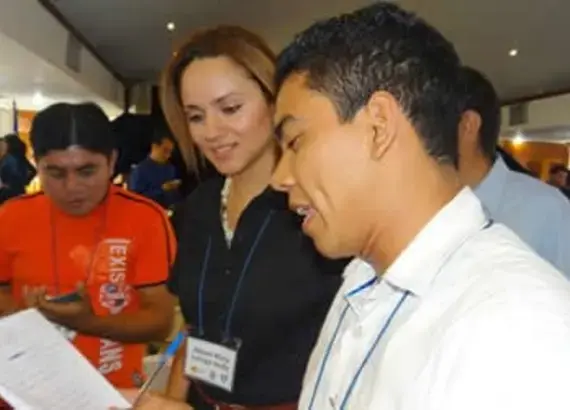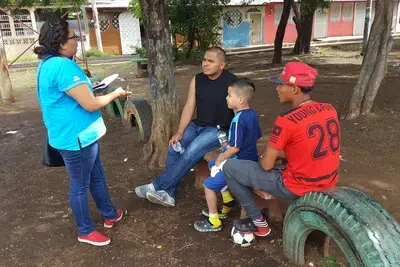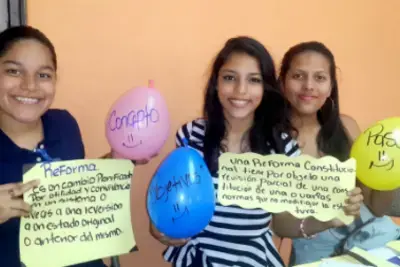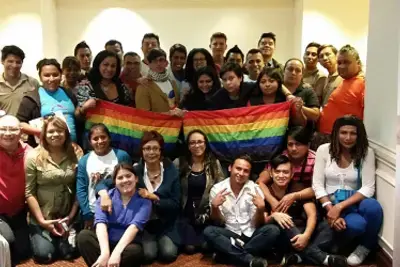
Success Story
Training Program Prepares Nicaragua's Next Generation of Leaders
Silvia Gutiérrez has been an active member of the Sandinista Renovation Movement (Movimiento de Renovación Sandinista, MRS) since she joined the party as a pollwatcher for Nicaragua’s 2006 presidential elections. After her bid for city council in her hometown of Managua in 2008 was cut short when her party was denied participation, she decided to improve her leadership and communication skills by attending a training program aimed at getting more young people involved in politics and civic life. Shortly after completing the program in 2011, the party chose her to run for the National Assembly, and in November of that year she was elected.
Selected CLPM Profiles

Marlon Zamora
Marlon Zamora is the environmental coordinator for NIQUIPO, a local NGO in Nueva Guinea focused on youth policy. After he participated in the CLPM program, Zamora was selected to attend a George Washington University Graduate School of Political Management (GSPM) seminar on leadership and effective governance in Washington last July. Upon his return, he became one of the key campaign advisers to the mayor of Nueva Guinea.
Read Marlon's full profile here.

Miriam Lara
Before participating in the CLPM, Miriam Lara, an active member of PLI, her political party, worked to train community residents in the department of Masaya to prepare for and respond to natural disasters. After completing the program, PLI selected Lara to run for city council. She was placed fourth on the party’s list of 32 candidates, but the party won only three seats.
Despite her narrow defeat, Lara continues to use the skills she learned in the CLPM to improve communities in Masaya by her work on the “Constructing Disaster Resilient Communities” project.
Read Miriam's full profile here.

Silvia Gutiérrez
After participating in the first year of the CLPM, Silvia Gutiérrez was selected by the MRS party to represent the department of Managua as a candidate for substitute deputy in the National Assembly. She was elected in November 2011 and credits the communication skills she gained through the program in helping her run a successful campaign.
“The tools that I gained have helped me become a more active member of the Assembly and to reach consensus across party lines,” she said.
Read Silvia's full profile here.
Gutiérrez is one of nearly 1,000 young leaders ages 16-35 who have taken part in the Certificate on Leadership and Political Management (CLPM), an annual five-part training program launched by NDI and its partners in 2010 aimed at equipping Nicaraguan youth with skills and knowledge to govern effectively.
Though nearly 70 percent of Nicaraguans are under 30, and more than 50 percent are women, both groups have been largely underrepresented in politics. Favoritism and a lack of transparency in Nicaraguan institutions have created a growing apathy and distrust among citizens. And political parties consistently rank last when citizens are asked about their confidence in democratic institutions, according to Latin American Public Opinion Poll surveys. The CLPM aims to overcome this by preparing young people like Gutiérrez to play a more prominent role in their parties and civic organizations through training focused on leadership, strategic planning, political communication and negotiation. It also concentrates on how to produce democracy that delivers results for citizens, including traditionally marginalized groups such as women, indigenous peoples and Afro-descendants.
Gutiérrez and nearly 50 other graduates from the program’s first two years gathered in Managua Dec. 5 for a day-long conversation about their experiences since graduating from the CLPM, and to share their successes as well as the challenges they have faced.
Participants discussed the goals they pursued with their political parties or civil society organizations, the obstacles they faced when attempting to carry them out, and what tools from the program were most helpful.
Twenty-two-year-old Marlon Zamora, an environmental coordinator for a Nicaraguan NGO, attended the program to strengthen his ability to communicate with local groups about the importance of protecting the environment. Afterward, Zamora was asked to help with the campaign of the mayor of Nueva Guinea, and soon became one of his key campaign advisers.
Miriam Lara was tapped by her party, the Independent Liberal Party (Partido Liberal Independiente, PLI), to run for city council in her home town of Granada after completing the CLPM last June. In November, she fell one spot short of winning a seat on the council, but credits the communication and campaign skills training she learned from the program for helping her come as far as she did.
Overall, participants were enthusiastic about the impact of the CLPM program on their work, with many saying it had helped them become more politically tolerant and work across political lines toward a more inclusive society.
“The leadership trainings helped me become more open and more tolerant in my political life,” said one graduate.
A number of graduates have risen to key positions within their party or organization, and several have run for municipal office. A Sandinista National Liberation Front (Frente Sandinista de Liberación Nacional, FSLN) alumna was recently appointed to head the party’s women’s wing, while a PLI alumnus was appointed to direct his party’s departmental youth wing. Civil society organization members have also demonstrated impressive progress. A local women’s network is working to replicate the content of the CLPM for rural residents of the Chontales department.
Despite these successes, participants noted that they faced several common challenges, including resistance to change within their parties or organizations—particularly from established leaders—as well as difficulty navigating Nicaragua’s tough political environment. Participants also recommended improvements for the program, such as extending courses so they could examine topics in greater depth. CLPM organizers plan to use this information to improve the program’s curriculum for the next year.
For the afternoon portion of event, NDI brought together for the first time more than 100 graduates of Nicaragua's three most prominent leadership schools – the Youth Leadership School (ELJ) and the Leadership Institute for Civil Society (ILSC), in addition to the CLPM – to help them identify how to achieve common goals. Attendees included youth leaders from 15 departments and two autonomous regions representing diverse civil society organizations and eight political parties. Participants were grouped by interest areas – such as jobs, education, citizen participation and economic development – and then worked to develop a common agenda and identify how to address shared priorities, such as gender equity and citizen participation.
The CLPM consortium includes the American University (Universidad Americana, UAM), the University of the Nicaraguan Caribbean Coast Autonomous Regions (Universidad de las Regiones Autónomas de la Costa Caribe Nicaragüense, URACCAN), the Institute for Development and Democracy (Instituto para el Desarrollo y la Democracia, IPADE) and the George Washington University Graduate School of Political Management (GSPM). The training program, which is funded by the U. S. Agency for International Development (USAID), takes place annually in five locations across the country: Managua, the capital city; Leon on the Pacific coast; Matagalpa in the north; and Bilwi and Bluefields in the Atlantic coast regions, where most of the country’s indigenous and Afro-Caribbean citizens live. Four hundred fifteen participants graduated from the first CLPM class which ran from Oct. 2010-May 2011, and 447 from the second, which ran from Jan.-June 2012. Students came from 12 political parties and more than 70 civil society organizations.
The third class of CLPM students will begin at the end of January 2013.
Related:
Published Jan. 14, 2013
Updated Jan. 15, 2013



